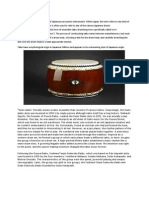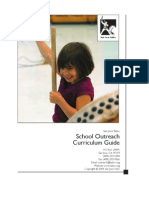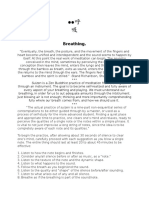Japanese Instruments
Japanese Instruments
Uploaded by
Ruel VillanuevaCopyright:
Available Formats
Japanese Instruments
Japanese Instruments
Uploaded by
Ruel VillanuevaOriginal Title
Copyright
Available Formats
Share this document
Did you find this document useful?
Is this content inappropriate?
Copyright:
Available Formats
Japanese Instruments
Japanese Instruments
Uploaded by
Ruel VillanuevaCopyright:
Available Formats
Japanese Instruments
Shinobue The shinobue (kanji: 篠笛; also
called takebue (kanji: 竹笛)) in the context of Japanese
traditional arts) is a Japanese transverse
flute or fue that has a high-pitched sound. It is found
in hayashi and nagauta ensembles, and plays important
roles in noh and kabuki theatre music. It is heard
in Shinto music such as kagura-den and in traditional
Japanese folk songs. There are two styles: uta (song)
and hayashi (festival). The uta is properly tuned to the
Western scale, and can be played in ensembles or as
a solo instrument. The hayashi is not in the
correct pitch, because it is simply a piece of
hollow bamboo with holes cut into it. It emits a very
high-pitched sound, and is appropriate for the
festival/folk music of Japan. Both shinobue flutes play
a very important role in the Japanese theater.
Shakuhachi
The shakuhachi (尺八、しゃくはち
, pronounced [ˌʃakʊˈhatʃi]) is a Japanese and Chinese
longitudinal, end-blown bamboo-flute.
It was originally introduced from China into Japan in
the 7th century and underwent a resurgence in the
early Edo period (17th century). The oldest shakuhachi
in Japan is currently stored in Shōsō-in, Nara. The
shakuhachi is traditionally made of bamboo, but
versions now exist in ABS and hardwoods. It was used
by the monks of the Fuke sect of Zen Buddhism in the
practice of suizen (吹禅, blowing meditation).
Koto Regarded as the national instrument in Japan, a koto
performance needs to be on your must-see list. The
koto is a string instrument that is placed on the ground
and plucked and is similar to the Korean gayageum and
Chinese zheng. Traditionally, the koto comes in two
varieties, a 13 -string type and a 17-string type. Now,
you can find some with 20, 21, or 25 strings! The koto
is very large — usually about 180 cm (about six feet!)
long — and made of kiri wood. The music made from
the koto is said to be romantic. Notable koto artists
include Yatsuhashi Kengyo, Tadao Sawai, and Kazu
Sawai.
Sho (Hosho) The island music of Japan is quite different than that of
the Caribbean. The sanshin, a string instrument made
with snakeskin from Okinawa, has more of a twang to
it than the laidback beats you might normally associate
with island life. ‘Sanshin’ translates to ‘three strings’,
and this instrument has just that. You have the male
string, the middle string, and the female string, with the
male string producing the lowest notes and the female
string producing the highest. The sanshin is often
compared to the banjo, but unlike the banjo, it is
plucked. The sanshin can be heard in traditional
Ryukyuan folk music or at graduations and other
special ceremonies in Okinawa. Interestingly, sanshin
scores use chinese characters as notes.
Taiko Arguably the most well-known Japanese instruments
internationally are taiko drums. Taiko drums are the
drums seen at many summer festivals in Japan and at
Japanese culture ceremonies worldwide. Wa-daiko (和
太鼓), or Japanese drums, come in many sizes and
shapes. One example is the tsuzumi, an hourglass-
shaped rope tension drum. Another is the byo-uchi-
daiko, a drum made out of a single piece of wood. The
most dramatic taiko is the oo-daiko. Oo-daiko are the
large drums you see in the back of a taiko ensemble.
You can see all of these drums used in a taiko drum
ensemble, called kumi-daiko (組太皷), where each
drum has a specific role and voiced calls help players
coordinate. Also, you can try your hand at taiko; visit
one of the many arcades in Tokyo to play Taiko no
Tatsujin, or Taiko Drum Master, to play this traditional
Japanese instrument to modern j-pop melodies.
You might also like
- Marshall Swift Life Expectacy GuidelinesDocument12 pagesMarshall Swift Life Expectacy GuidelinesAndikaNo ratings yet
- The Crucible Study Guide QuestionsDocument4 pagesThe Crucible Study Guide QuestionsDanny Trevino100% (1)
- E-Bill From Enagic India PDFDocument3 pagesE-Bill From Enagic India PDFHitesh ChavdaNo ratings yet
- Guangdong Yinyue MEP Music NotesDocument4 pagesGuangdong Yinyue MEP Music NotesThomas RettigNo ratings yet
- World MusicDocument5 pagesWorld MusicFELLICIA PAMELLA FRANCISNo ratings yet
- Taiko Study GuideDocument14 pagesTaiko Study GuideBrianNo ratings yet
- The Shakuhachi and The Kin Koryu NotationDocument42 pagesThe Shakuhachi and The Kin Koryu NotationCaio Vinicius MartinsNo ratings yet
- 7ps of Toyota Marketing MixDocument2 pages7ps of Toyota Marketing MixRuel VillanuevaNo ratings yet
- 7 Ps of Toshiba Marketing MixDocument5 pages7 Ps of Toshiba Marketing MixRuel VillanuevaNo ratings yet
- Case Study RBS Stan MaklanDocument24 pagesCase Study RBS Stan MaklanRayan BaredNo ratings yet
- DELVRY03 IDOC To EDIFACT DESADV D96A Mapping Template For AMAZON UpdatedDocument27 pagesDELVRY03 IDOC To EDIFACT DESADV D96A Mapping Template For AMAZON UpdatedsatishNo ratings yet
- Traditional Japanese MusicDocument8 pagesTraditional Japanese MusicGamingWithCactus ReactesNo ratings yet
- Gagaku InstrumentsDocument12 pagesGagaku Instrumentsgabrielluis08No ratings yet
- Japanese Musical InstrumentsDocument5 pagesJapanese Musical Instrumentsjosiah venice100% (1)
- TaikopedroDocument15 pagesTaikopedroapi-341712673No ratings yet
- Taiko JoyDocument2 pagesTaiko JoySi OneilNo ratings yet
- REGAN Composing JapanDocument18 pagesREGAN Composing JapanFrancisco Javier González-Velandia GómezNo ratings yet
- World Music Revision Sheet FINAL PDFDocument2 pagesWorld Music Revision Sheet FINAL PDFScott Adelman100% (1)
- G8 Music 3rd QuarterDocument8 pagesG8 Music 3rd QuarterNancy GelizonNo ratings yet
- 2010 Japanese Traditional Music EnglishDocument33 pages2010 Japanese Traditional Music EnglishNabin BajracharyaNo ratings yet
- Ma. Reina Gail T. Lizaso: DiscussantDocument58 pagesMa. Reina Gail T. Lizaso: DiscussantMa. Reina Gail T. Lizaso100% (2)
- SWV Resource Pack TalkingdrumDocument21 pagesSWV Resource Pack TalkingdrumAfolabi OluwafemiNo ratings yet
- Epgc&Printsec Frontcover&Dq Korean+Pop&Hl En&Ei P9Ujtreahmxymaxc6Bmla Q&Sa X&Oi Book - Result&Ct Result&Resnum 2&ved 0Cc0Q6Aewaq#V Onepage& Q&F FalseDocument1 pageEpgc&Printsec Frontcover&Dq Korean+Pop&Hl En&Ei P9Ujtreahmxymaxc6Bmla Q&Sa X&Oi Book - Result&Ct Result&Resnum 2&ved 0Cc0Q6Aewaq#V Onepage& Q&F FalseNJPMsmashNo ratings yet
- Taiko ResourcesDocument17 pagesTaiko ResourcesBenjamin Pachter0% (1)
- Tsugaru Shamisen: Bachi. The Tsugaru Shamisen Is A Kind of ShamisenDocument1 pageTsugaru Shamisen: Bachi. The Tsugaru Shamisen Is A Kind of ShamisenrenewedNo ratings yet
- Jin Nyodo SymbolsDocument2 pagesJin Nyodo SymbolsSantiago ButvilofskyNo ratings yet
- Belibou 1:2017 SpecialDocument7 pagesBelibou 1:2017 SpecialAlexandra BelibouNo ratings yet
- Colin McPhee Balinese CeremonialDocument2 pagesColin McPhee Balinese CeremonialDolfiParthaHutagalungNo ratings yet
- Music CurriculumDocument47 pagesMusic CurriculumAlex TeeNo ratings yet
- Carnatic Music SynthesisDocument11 pagesCarnatic Music SynthesistelugutalliNo ratings yet
- BeatboxingDocument2 pagesBeatboxingSon Chaeyoung MinariNo ratings yet
- Madtshirtt (By Y7)Document1 pageMadtshirtt (By Y7)njd438No ratings yet
- Koizumi TetrachordDocument198 pagesKoizumi TetrachordRomullo QueirozNo ratings yet
- Unit 19 Music and SocietyDocument11 pagesUnit 19 Music and SocietynorthernmeldrewNo ratings yet
- Study Guide - San Jose TaikoDocument16 pagesStudy Guide - San Jose TaikomontalvoartsNo ratings yet
- Hip Hop Culture - History and TrajectoryDocument33 pagesHip Hop Culture - History and TrajectoryVince SardinaNo ratings yet
- Listening To Indian Classical MusicDocument6 pagesListening To Indian Classical MusicBhairava Sanjay NathaNo ratings yet
- Rhythm: Rhythm (from Greek ῥυθμός-rhythmos, "any regular recurringDocument10 pagesRhythm: Rhythm (from Greek ῥυθμός-rhythmos, "any regular recurringGiulia Galli LavigneNo ratings yet
- Audiation and Music Moves For PianoDocument1 pageAudiation and Music Moves For PianoJoão Pedro ReigadoNo ratings yet
- Bon) Are Accompanied by Singers and Sometimes Flute, Drum, and Shamisen, A Three-StringedDocument3 pagesBon) Are Accompanied by Singers and Sometimes Flute, Drum, and Shamisen, A Three-StringedOlushola AdebisiNo ratings yet
- The Vocaloid Phenomenon - A Glimpse Into The Future of SongwritinDocument86 pagesThe Vocaloid Phenomenon - A Glimpse Into The Future of SongwritinJoshua BustamanteNo ratings yet
- Jazz MusicDocument26 pagesJazz MusicTeresita Casalan GanabaNo ratings yet
- Darius MilhaudDocument72 pagesDarius MilhaudJOSE VICENTENo ratings yet
- Bernard Herman (1911-1975) - An American Comp Composer and Conductor WhoDocument5 pagesBernard Herman (1911-1975) - An American Comp Composer and Conductor WhoWoodface1No ratings yet
- Goa Trance - HistoryDocument11 pagesGoa Trance - HistoryPavlos AvourisNo ratings yet
- English Gong YoDocument30 pagesEnglish Gong Yomitukhurana100% (1)
- Varna Music and MinoritiesDocument82 pagesVarna Music and Minoritiespedroroxo3000No ratings yet
- Religious Music Buddhism KoreaDocument9 pagesReligious Music Buddhism KoreaIlo KoNo ratings yet
- Monotrail Tech Talk - 06 Get More Out of Your Beatstep ProDocument6 pagesMonotrail Tech Talk - 06 Get More Out of Your Beatstep Proscobra427No ratings yet
- Music Perception and Cognition: Development, Neural Basis, and Rehabilitative Use of MusicDocument11 pagesMusic Perception and Cognition: Development, Neural Basis, and Rehabilitative Use of MusicAutes AG100% (1)
- Indian Folk MusicDocument25 pagesIndian Folk MusicthujoiNo ratings yet
- Japanese Music - Their Culture and LifeDocument20 pagesJapanese Music - Their Culture and LifeWendel MatiasNo ratings yet
- Secondary/Key Stage 3 Music - Saharan SoundsDocument5 pagesSecondary/Key Stage 3 Music - Saharan Soundsvcecilia2002No ratings yet
- Breathing.: Suizen Is A Zen Buddhist Practice of Meditation From Blowing AirDocument2 pagesBreathing.: Suizen Is A Zen Buddhist Practice of Meditation From Blowing AirEvan SanchezNo ratings yet
- Hip Hop ModernDocument22 pagesHip Hop ModernErizoNo ratings yet
- Pictures of Musical InstrumentsDocument8 pagesPictures of Musical InstrumentsEluwole GbengaNo ratings yet
- Introduction To Tabla,: The Ancient Indian DrumsDocument10 pagesIntroduction To Tabla,: The Ancient Indian DrumsAkshay KNo ratings yet
- アシタカとサン chamberDocument6 pagesアシタカとサン chamberThéotime DijouxNo ratings yet
- Monotrail Tech Talk - 09 Introduction To Generative MusicDocument5 pagesMonotrail Tech Talk - 09 Introduction To Generative Musicscobra427No ratings yet
- Musical Instruments of AfricaDocument6 pagesMusical Instruments of AfricaRica Jane TorresNo ratings yet
- KalimbaDocument7 pagesKalimbananznanzNo ratings yet
- Music of KoreaDocument14 pagesMusic of KoreaDarwinn DonqueNo ratings yet
- History of Collection and Recording of Samples of Uzbek Music FolkloreDocument4 pagesHistory of Collection and Recording of Samples of Uzbek Music FolkloreEditor IJTSRDNo ratings yet
- Percussion InstrumentsDocument3 pagesPercussion InstrumentsManish PatelNo ratings yet
- CCFCS collection of musical instruments: Volume 3: CordophonesFrom EverandCCFCS collection of musical instruments: Volume 3: CordophonesNo ratings yet
- Korean InstrumentsDocument2 pagesKorean InstrumentsRuel VillanuevaNo ratings yet
- Korean Musical InstrumentsDocument2 pagesKorean Musical InstrumentsRuel VillanuevaNo ratings yet
- Departments of The Philippine GovernmentDocument7 pagesDepartments of The Philippine GovernmentRuel VillanuevaNo ratings yet
- Ethnic Ways of Cooking Vegetable in The PhilippinesDocument25 pagesEthnic Ways of Cooking Vegetable in The PhilippinesRuel VillanuevaNo ratings yet
- Cnditional ProbabilityDocument5 pagesCnditional ProbabilityRuel VillanuevaNo ratings yet
- Badminton TerminologyDocument7 pagesBadminton TerminologyRuel VillanuevaNo ratings yet
- Chinese Musical InstrumentsDocument2 pagesChinese Musical InstrumentsRuel VillanuevaNo ratings yet
- The Filipino Is Worth Dying ForDocument2 pagesThe Filipino Is Worth Dying ForRuel VillanuevaNo ratings yet
- Chinese InstrumentsDocument2 pagesChinese InstrumentsRuel VillanuevaNo ratings yet
- Burmese LiteratureDocument9 pagesBurmese LiteratureRuel VillanuevaNo ratings yet
- The Girl On The Train - ExcerptDocument6 pagesThe Girl On The Train - ExcerptilsabrinkNo ratings yet
- Hunger Critical AppreciationDocument5 pagesHunger Critical AppreciationDaffodil100% (2)
- Rulings in Agrarian CasesDocument6 pagesRulings in Agrarian CasesXavier Hawkins Lopez ZamoraNo ratings yet
- Practice 9 - ECON1010Document13 pagesPractice 9 - ECON1010sonNo ratings yet
- Urbanization in NepalDocument7 pagesUrbanization in NepalSagar Sunuwar100% (1)
- Imt 51Document4 pagesImt 51arun1974No ratings yet
- 6c6c PDFDocument1 page6c6c PDFshaziba noorNo ratings yet
- Seminar On Sixth CantoDocument121 pagesSeminar On Sixth CantoSamaksh KumarNo ratings yet
- Module 3 Manage Users, Multi Currency, Chart of AccountsDocument24 pagesModule 3 Manage Users, Multi Currency, Chart of AccountsOsapac IncNo ratings yet
- Bible Reading PlanDocument2 pagesBible Reading PlanbrandonsmithitNo ratings yet
- CHP597 - FOX615 Multiservice Platform Advanced FeaturesDocument2 pagesCHP597 - FOX615 Multiservice Platform Advanced FeaturesMichael Parohinog GregasNo ratings yet
- GR 8 MSCS Syllabus 24-25Document4 pagesGR 8 MSCS Syllabus 24-25mohammedaryanhabib10No ratings yet
- Legislative History, Pole Attachment Act of 1978Document5 pagesLegislative History, Pole Attachment Act of 1978StimulatingBroadband.comNo ratings yet
- Empire of The Hajj - Pilgrims Plagues and Pan-Islam Under BritisDocument211 pagesEmpire of The Hajj - Pilgrims Plagues and Pan-Islam Under BritisOs EgehNo ratings yet
- Recommendation Letter For AlbertaDocument1 pageRecommendation Letter For AlbertaAlberta SotnikovaNo ratings yet
- Iso 45001:2018Document3 pagesIso 45001:2018fansamaster57% (7)
- To Make Tourists Pay A Tax When They Come Into The Country.Document1 pageTo Make Tourists Pay A Tax When They Come Into The Country.cahojax367No ratings yet
- Pen 2603 Community Corrections AssessmentDocument3 pagesPen 2603 Community Corrections Assessmentkagisowest39No ratings yet
- FDA Object EvidenceDocument3 pagesFDA Object Evidenceaurea belenNo ratings yet
- Upsc 2022 GS 2 Notes by Ias NetworkDocument292 pagesUpsc 2022 GS 2 Notes by Ias NetworkBiJu BairagiNo ratings yet
- Sandhya Live ProjectDocument41 pagesSandhya Live ProjectsathvikaNo ratings yet
- ArnisDocument18 pagesArnisfelices.rossevanNo ratings yet
- Describing TablesDocument1 pageDescribing TablesKusal DamsaraNo ratings yet
- Information System InfrastructureDocument55 pagesInformation System InfrastructureVinoth RajNo ratings yet
- Thesis PresentationDocument14 pagesThesis Presentationmissycoleen05100% (1)





































































































